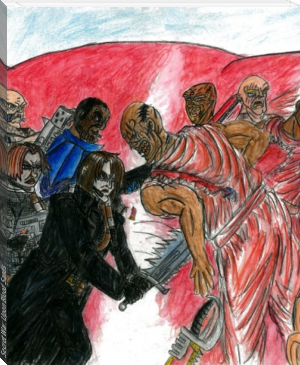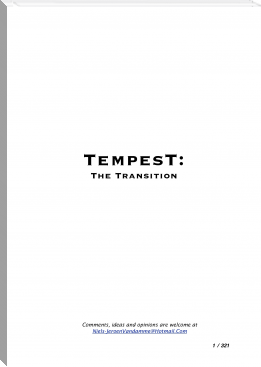Tree Rings by Brian Doswell (reading like a writer TXT) 📖

- Author: Brian Doswell
Book online «Tree Rings by Brian Doswell (reading like a writer TXT) 📖». Author Brian Doswell
Dendrochronology – an Exact Science?
(dendro = tree – chronology = time)
The basic concept of dendrochronology is that the cross section of a tree trunk displays a series of concentric rings and that each year of the tree’s growth can be measured by the width of each ring. The theory is that it is possible to match the various growth rings from tree to tree to establish a pattern of growth in any given area. It is then further possible to match the pattern of growth shown in these tree rings, to past trees, now found in the cross sections of timber in furniture and architecture. The assumption is that the principal reason for the rings to vary in any tree, or group of trees, is the climate during the corresponding year. If you put these two ideas together, it is theoretically possible to track backwards in time by overlapping corresponding patterns of tree rings and thereby show an approximation of the climatic conditions in past ages. Part science, part fiction, or perhaps assumption?
Using this premise, the years 542AD and 543AD consistently show a minimal growth in tree rings throughout the western world, which means two very bad years for the trees and by inference, for anything else that might be trying to grow in the soil. Experts now believe that this period of zero growth led not just to the failure of the crops for two years running, but also to a general famine which lasted for a minimum of two years and most probably three to five years before sustainable crops were available to feed a decimated population.
In these terrible, desolate times, food stocks dwindled to virtually nothing. The Roman occupation throughout the European continent had left a strong legacy of crop management with elaborate systems of grain silos which had been copied even in the northern lands, well beyond the Roman Empire but, strong as it was, the silos were empty by the end of the second year.
The first casualties were the animals, either because they had nothing to graze on, or because they were slaughtered for human food. Soon afterwards the old and infirm were abandoned in favour of those who could still fight for food, for themselves and for their children. Then the children died.
Eventually there were just a few small groups of the fittest adults plus some small tribes who lived near the coast and could still catch fish from the deeper offshore waters.
English school history calls this time the ‘Dark Ages’. There are no histories to match the copious and complete writings of the previous centuries. There are no records of trade nor are there any learned books or scripts for artisans of any craft. Most significantly, there are no religious tracts dated to this time. In fact it was to be almost three hundred years before anyone put pen to paper again.
The name ‘Dark Ages’ was doubtless picked at random by some erudite professor of history. However, it may be more than just a lucky guess because in fact it was indeed a darkness that spread over the entire world. No one would then have known, or perhaps understood, that the cold dark winter of 541AD was because the sky was full of ash. The ash spewed out of a volcano in what we now know as Java, not far from the present island site of Krakatoa which has erupted in more recent times. In fact the ash spewed out of the volcano for six months during which time several other volcanoes on the same fault line, which modern day geologists see as the tectonic plate line west of Malaysia, followed suit.
The series of eruptions continued until the late summer of 542AD when the tectonic plate line was so weakened that it literally pulled the Malay Peninsula several miles to the west, causing the east coast of the peninsula and its northern continuation to split with what were subsequently to become the islands of Japan.
It is impossible today to measure the volume of debris that was ejected into the atmosphere by these continued volcanic events, but it is clear that the power of these explosions gave rise to winds of cosmic force and the material that hung in the air was swept around the world, not once, but many times.
It is also clear that the western European lands, virtually on the opposite site of the globe, were at the nadir point of the wind force and therefore subject to the maximum fallout of ash and debris, which, in many ways, explains the depth of so many Roman excavations after so few years. Almost all inhabitable buildings were damaged, if not buried and destroyed, by the continual battering month after month.
The years 542AD and 543AD saw no sunshine at all under the continual rainfall of earth and rock, sometimes as fine as sand and sometimes like coarse gravel. For many places on the western side of England it was a time of perpetual night. Winds, laden with debris, arriving from the western ocean were forced to rise over the Pennine ridge and, in being slowed, were able to deposit their fine loam on the hills and dales of what is now Lancashire and Yorkshire.
The last of the eruptions was in the autumn of 543AD.
Much of the airborne debris was now returned to the surface of the planet from whose depths it had come. The skies began to clear, but it was mid-winter and the turbulent global winds had not yet abated. Shortly after the winter solstice it began to rain. The winds lifted water from the oceans onto the land and, as ever, it rained on Manchester first. The rain was a mixed blessing in that it cleared the skies of the remaining dust but it also flooded the land, turning the soft, newly deposited soil into a quagmire in which still nothing grew.
The spring of 544AD saw the first real sunshine in almost three years but, by then, the land was barren and spoiled. It is a miracle that anyone survived those years but clearly some did. A few of the stronger adults had managed to scratch a living in corners of the land where they were able to find shelter, enough food to eat and clean water to drink. There were virtually no children and no animals. The few survivors were separated by great distances, mainly because nowhere was there enough to support more than one or two hungry mouths. Individuals were forced to spread out across the country in search of food. The populations of towns either died or left to forage wherever they could. But, with the sunshine, came new hope.
Throughout the summer of 544AD the survivors drifted back towards their former homes, but nothing was as before. The survivors were almost all young male adults, old enough to remember the way things were, a mere three years before, but too young to have gained the wisdom of age. None were skilled artisans. None were literate poets, scribes or artists.
The intense global wind patterns continued through the winter of 544AD and into the spring of 545AD. The winter was not especially cold but the wind chill factor made it feel so. Those survivors who had recovered homes among the debris, or built new homes from the loose stones of previous houses, now burned anything that they could find for body warmth. As always, the nearest to hand went on the fire first. Books, furniture and works of art were useless aids to survival and burned well. In many ways, civilisation died more that winter from looting and wanton waste, than in the desolate years before.
As the spring of 545AD turned into summer, peace returned to the atmosphere and Mother Nature sensing this, returned to her job of providing new growth in the land. Old plants and new wind-borne seeds generated in sufficient quantities for the survivors to grub a meagre living from the land. In areas where the previously cultivated fields were buried to a lesser degree, crops grew again. The threat of starvation began to recede.
Now came a new problem.
The survivors were predominately young males, and, nature being what it is, the urge to continue the species led to a frantic search for young, child-bearing women. Less than one woman had survived for every hundred man. At first there was a scramble for mating rights but then, fortunately, sanity prevailed. The food supplies were still minimal and people were still forced to spread across the land in order to feed themselves. It was a period of ‘alpha male’ behaviour where the value of continued existence outweighed the need to procreate. Those lesser young males merely went away to another field, hoping to find somewhere where they might become an ‘alpha male’.
Women were highly prized. It is difficult to say if they were regarded as possessions or as objects of desire. It is, however, apparent that women held the whip hand. Alpha male, or not, in the final analysis, the women usually chose their partners.
It is a fact of life, or nature, that the gestation time for a new baby is almost a full year and young girls do not become fertile until another twelve years have passed. With luck, there might be five or maybe six generations in a century. Studies of demographics now tell us that until a community reaches a norm of twenty mating couples, it has a high risk of failing to survival.
These simple, immutable facts taken together meant that it would be at least a hundred years before anything like a recognisable community could be found anywhere in any of the European lands.
As time passed, small groups banded together to provide more hands to forage or work in the fields and, more essential breeding stock. Unfortunately the alpha male existence had become ingrained behaviour and each group, be it small or large, produced a dominant, power seeking leader. We now know that this behaviour pattern led to an increasing round of smaller groups being forcibly captured into larger ones until kingdoms emerged laying claim to the territory on which they depended for food and survival.
This in turn gave rise to other problems. Not every ‘captured’ group came with equally productive lands. Furthermore, from time to time, the breeding stock were more successful than the foragers and farmers, which forced the king to battle with his neighbours in the search for new resources to support his growing tribe.
The years from 550D to 650AD saw humanity hanging on by a finger nail, but the following century turned into one of bloodshed and mayhem as emerging kingdoms fought to establish and safeguard their existence.
The warm weather patterns that we now know as the ‘gulf stream drift’, enabled the western edges of the European continent to become fertile and hence desirable to those who lived where the poorer climate hindered their recovery. People from the near northern lands, now known as Vikings, were sufficiently motivated to risk their lives in small wooden boats to cross miles of open sea





Comments (0)